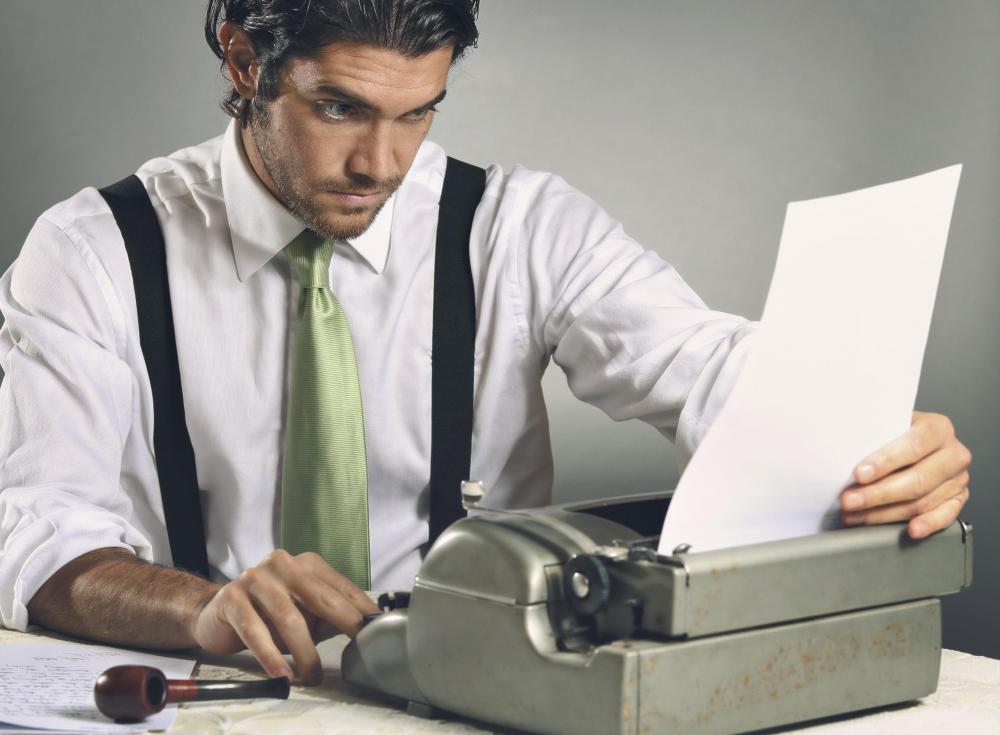At WiseGEEK, we're committed to delivering accurate, trustworthy information. Our expert-authored content is rigorously fact-checked and sourced from credible authorities. Discover how we uphold the highest standards in providing you with reliable knowledge.
What is a Typewriter?
A typewriter is a device which prints letters one at a time on a medium such as paper when the user presses keys on the keyboard. Before the advent of word processors and computers, the typewriter was the only way for people to produce printed text in an efficient and rapid manner, and typewriters in fact continue to be used in some offices today. Many fine examples of antique typewriters can be seen in some museums, along with examples of innovations such as typeballs and electric typewriters.
The earliest versions of the typewriter began to appear around the 1700s, but the development of the typewriter really entered its full flower in the 1800s, and while the design was refined a bit in the 1900s, it remained fundamentally the same. There are a several main parts to the typewriter: the keyboard, the typing levers, an ink ribbon, and the platen, all encased in a housing which protects the innards of the typewriter.

The platen is the section of the typewriter which holds the paper. Most platens are rollers which advance the paper with each line, so that the typist can focus on the typing. To use the typewriter, the typist presses a key which activates a lever attached to the corresponding letter, number, or symbol. As the lever is pushed forward, it strikes a ribbon which is impregnated with ink, and then the paper, leaving an impression of the desired symbol behind.

Early typists often struggled with jams, especially when they typed quickly, because the levers could not return to their resting positions quickly enough. As a result, typewriter companies developed keyboard layouts which were deliberately designed to slow typists; the QWERTY keyboard endures to this day, despite much more efficient keyboard layouts which are usable with word processors.

One of the first major innovations for the typewriter was the development of a typeball, which mounted all of the letters on a sphere, eliminating jams. The other convenient thing about typeballs is that they are removable, allowing people to switch to different alphabets and typeballs with special characters. Later typewriters used electrical impulses to send signals, rather than creating a mechanical connection, and this ultimately resulted in memory typewriters, where typists could enter a set number of characters which would all be printed at once. These rudimentary word processors became steadily more sophisticated until computers dominated the market with their multitude of features in addition to word processing.

One of the major issues with typewriter usage is that correcting errors is very time consuming. There are a number of ways to correct errors with a typewriter, ranging from using a correction ribbon in more modernized typewriters to actually erasing the ink and typing over it. Typists in a hurry might simply back up over the error and X it out, although this is frowned upon for actual correspondence. Because typewriters are not as forgiving as word processors, accuracy and speed are crucial for typists.
Many people have romantic associations with the typewriter, thanks to a plethora of famous 19th and 20th century authors who worked on typewriters, and some authors still enjoy the sensation of using a typewriter. It is very easy to find well-maintained vintage typewriters for sale in various locales, and some companies continue to produce typewriters for the public. One of the main advantages to a classic typewriter is that it works even when there is no electricity, allowing people to produced polished printed materials quickly in a wide variety of environments.
AS FEATURED ON:
AS FEATURED ON:














Discussion Comments
@anon334321: Believe it or not, there are still a few advantages of using a typewriter. Sometimes an older form, like a card catalog entry or police fingerprint card, isn't available as an electronic file. A typewriter is the best way to line up a space and type in a name or other information on these cards.
A typewriter can also do some creative formatting that standard word processing programs can't duplicate. A poet may want to experiment with the visual placement of letters and words on a page, for example. A typewriter can be used to create offset lines and decorative borders, too.
The font style of some older typewriters may also be difficult to duplicate precisely with a modern word processor. Some people prefer the distressed look of a real typewriter over the artificially distressed look of an "old typewriter" font on a word processor.
What are the advantages of using a typewriter?
Can you help me? I bought a 1940 Underwood typewriter and when I got it out of the box, I noticed some bearing in the bottom of the box and now it will not advance when typing and the carriage will return but goes to the center of the page. Is there something loose or I can look at and maybe repair without having to send this back to the seller?
I always prefer electric typewriters over manual because error correction features are usually far better than the alternatives for manual typewriting.
It is true that you always need a power source for electric typewriters, but making typing errors is inevitable and constantly rewriting whole pages is annoying.
I have an electric Brother typewriter, and the lift off error correction tape makes it a very useful device to use when my computer is in rest mode or when I have to quickly write a note. After all, printer ink/toner is expensive!
Post your comments